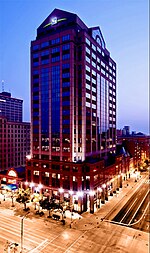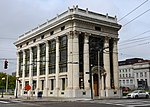Dayton Arcade

The Dayton Arcade is a collection of nine buildings in Dayton, Ohio. The Arcade is a historic, architecturally elegant complex in the heart of Dayton's central business district. Built between 1902 and 1904, it was conceived by Eugene J. Barney of the Barney & Smith Car Company and consists of nine interconnecting buildings topped by a glass-domed rotunda, 70 feet (21 m) high and 90 feet (27 m) in diameter (detailing around the dome includes oak leaves and acorns, grain, rams' heads, wild turkeys, and cornucopia), below which two balconied upper floors circle the central enclave. As president of the Arcade Company, Barney made sure the Arcade had the latest innovations, including elevators, a power plant and a cold-storage plant. The architect was Frank M. Andrews, known also as architect for many of NCR's factory buildings (notable for their use of progressive fenestration) and the American Building (originally Conover) at Third and Main Streets in Dayton.
Excerpt from the Wikipedia article Dayton Arcade (License: CC BY-SA 3.0, Authors, Images).Dayton Arcade
West 4th Street, Dayton
Geographical coordinates (GPS) Address Website Nearby Places Show on map
Geographical coordinates (GPS)
| Latitude | Longitude |
|---|---|
| N 39.758333333333 ° | E -84.1925 ° |
Address
The Arcade Dayton
West 4th Street 35
45402 Dayton
Ohio, United States
Open on Google Maps










